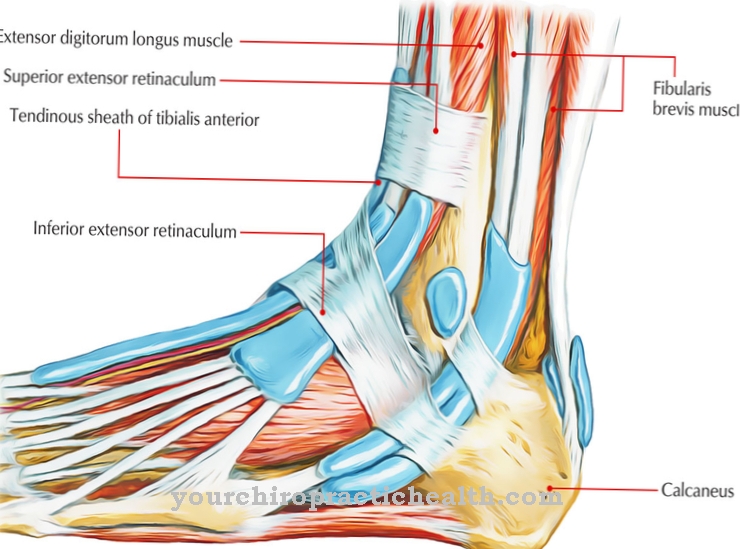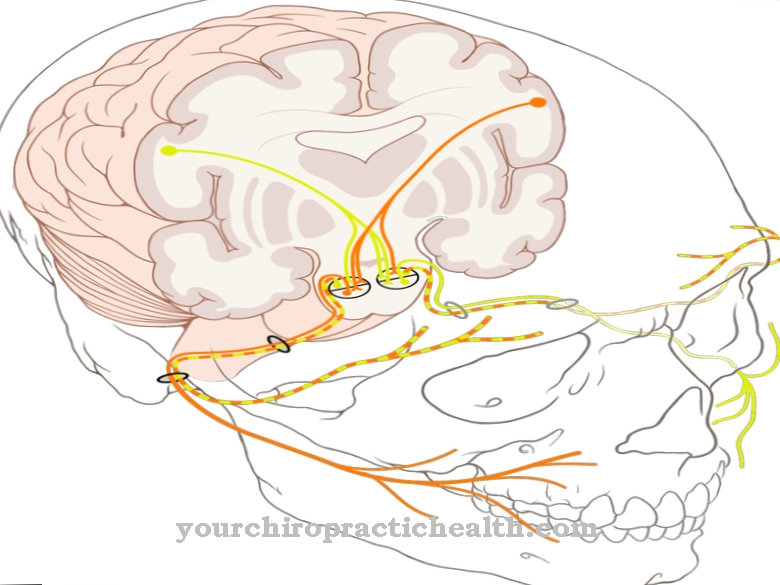The Occipital artery is a blood vessel that is involved in supplying blood to the muscles of the neck and back. In addition, the artery supplies the occipital region (Regio occipitalis). Pulse-synchronous tinnitus can be associated with disorders of the occipital artery, for example arteriovenous fistulas or circulatory disorders caused by arteriosclerosis.
What is the occipital artery?
Part of the head and certain areas of the neck and back muscles receive arterial blood from the occipital artery. Because of its function, it rarely bears the name in German Occipital artery.
It branches off from the external carotid artery, which is also known as the external carotid artery and in turn represents a branch of the common carotid artery (common carotid artery). The occipital artery divides in its course into different branches, which the technical language knows as rami. In the circulatory system or large bloodstream, arteries carry oxygen-rich blood from the lungs to more distant cells.
Without a sufficient supply of breathing gas, the cells of the human body cannot function and eventually die. The oxygen-depleted blood flows out through veins. In the pulmonary circulation, however, the arteries transport oxygen-poor blood and the veins are responsible for transporting oxygen-rich blood.
Anatomy & structure
The occipital artery separates from the external carotid artery at the digastric muscle and continues towards the head (cranial), past the internal carotid artery, the internal jugular vein, the vagus nerve and the accessory nerve. At the temporal bone (Os temporale) the course of the occipital artery runs through the sulcus arteriae occipitalis.
This is a groove in the temporal bone that lies in the mastoid part of the bone. In the occipital region (regio occipitalis) the branches of the occipital artery run under the scalp. The anatomy differentiates between five different branches: Ramus auricularis, Ramus descendens, Ramus meningeus, Rami musculares and Ramus sternocleidomastoideus. They each supply different anatomical structures with arterial blood. The branches then converge in the auricular arteries and the superficial temporal arteries.
In some people, the occipital artery does not originate from the external carotid artery, but rather the internal carotid artery. This deviation from the normal origin represents an anatomical variant. If the occipital artery branches off from the external carotid artery, as in most cases, its origin lies opposite the branch of the facial artery (arteria facialis).
Function & tasks
The job of the occipital artery is to supply blood to different regions, with its branches helping to distribute the blood accordingly.The ramus auricularis forwards blood to the auricle (auricula auris), which is involved in acoustic perception and, thanks to its spatial shape, enables the direction of a sound to be determined.
Larger than the auricular branch and all other branches of the occipital artery is the descending branch, which is responsible for parts of the skin, for the periosteum of the occipital region and for the trapezius muscle (Musculus trapezius). In contrast, the meningeal branch is responsible for the blood supply to the meninges or dura mater at the posterior cranial fossa. Arterial blood flows through the rami musculares to suprahyoid muscles (digastric muscles and stylohyoid muscles) and back muscles (splenius muscles and longissimus capitis muscles).
Finally, the ramus sternocleidomastoideus ensures the supply of the sternocleidomastoid muscle, which is involved as a "nodder" in side and backward head movements and serves as an auxiliary breathing muscle when the head is immobile. In an anatomical variant, the sternocleidomastoid branch does not branch off from the occipital artery, but from the larger external carotid artery.
Diseases
In connection with the occipital artery, ringing in the ears can occur. They are also known as tinnitus aurium and are expressed in whistling, hissing, cracking or other sounds that those affected perceive even though there is no external acoustic stimulus.
Since there are numerous possible causes of tinnitus, individual clarification is necessary in each case. Circulatory disorders of the occipital artery or other blood vessels are not the only possible cause of the noise in the ear: Tinnitus often manifests itself in the context of a sudden hearing loss or as a result of excessive psychological stress. Cervical vertebrae complaints, increased intracranial pressure, tumors and Menière's disease are other potential causes.
Hearing impairment can accompany the noise in the ear, but it does not always occur. In addition to possible other physiological aspects, tinnitus often also puts a psychological burden on those affected, which can result in further complaints such as sleep disorders and concentration problems. Many patients experience tinnitus as grueling.
Arteriovenous fistulas in the occipital artery can cause pulse-synchronous tinnitus. An arteriovenous fistula is what is known as a short circuit between artery and vein: an unwanted connection forms between the blood vessels. An undersupply of the area that depends on the artery is possible. In addition, the change in blood flow can prevent the blood in the vein from flowing freely in the correct direction. Tinnitus as a result of such an arteriovenous fistula is often manifested as a hissing sound. The short circuit between artery and vein can be congenital or caused by injuries.
Another possible cause of tinnitus is damage from arteriosclerosis. The deposits of calcium, thrombi, fat or connective tissue constrict the inside of the blood vessel and can lead to complete closure. In addition, the blood flow can carry away such obstacles and cause circulatory disorders elsewhere.













.jpg)

.jpg)
.jpg)











.jpg)